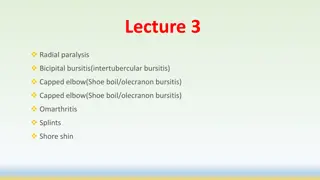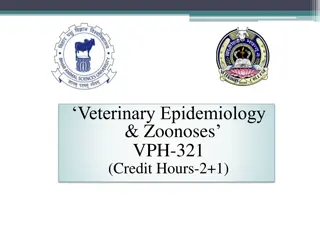Skeletal Muscle Relaxants and Neuromuscular Blockade
Skeletal muscle relaxants are used to induce muscle relaxation during surgeries. Neuromuscular blocking agents act at the neuromuscular junction. These drugs can either peripherally reduce muscle tone or centrally cause muscle paralysis. Different types of muscle relaxants are classified based on th
6 views • 23 slides
Understanding Blood Groups and Their Significance
Human blood types are determined by specific antigens and antibodies present on red blood cells, influencing crucial aspects like blood transfusions and familial relationships in forensic medicine. The ABO system, with its four main blood types (A, B, AB, O), plays a vital role in categorizing blood
7 views • 14 slides
Common Elbow and Shoulder Joint Conditions in Veterinary Medicine
Learn about radial paralysis, bicipital bursitis, capped elbow, and omarthritis in veterinary medicine. Understand the etiology, symptoms, and treatment options for these conditions, including corticosteroid injections and surgical debridement. Recognize the signs of omarthritis and how it affects j
1 views • 15 slides
Veterinary Management of Jaw Affections and Treatments
Affections of the jaw in animals can range from congenital conditions to inflammatory diseases like gnathitis and lymphadenitis. Paralysis of the lower jaw, gnathitis from bit injuries, and lymphadenitis are discussed, along with their etiology, clinical signs, and treatment options such as general
0 views • 20 slides
Understanding Rabies: Epidemiology, Etiology, and Control Measures
Rabies is an acute fatal disease affecting humans and warm-blooded animals worldwide. It is characterized by abnormal behavior, nervous disturbances, and ultimately death due to respiratory paralysis. Rabies claims approximately 55,000 human lives annually, with efforts at control showing marginal s
1 views • 22 slides
Understanding Polio Eradication Efforts and Vaccine Development
Polio, a disabling disease caused by the poliovirus, mainly affects children and can lead to paralysis. Efforts to eradicate polio include the development of vaccines like the Inactivated Polio Vaccine (IPV) and Oral Polio Vaccine (OPV). The poliovirus' choice of host, ease of transmission, and impa
0 views • 15 slides
Understanding Instruction Set Architecture and Data Types in Computer Systems
In computer architecture, the Instruction Set Architecture (ISA) level is crucial in defining how a processor executes instructions. This includes the formal defining documents, memory models, registers, and various data types that can be supported. The ISA level specifies the capabilities of a proc
2 views • 13 slides
Understanding Rabies: A Comprehensive Overview
Rabies is an acute fatal disease affecting humans and warm-blooded animals, characterized by abnormal behavior, nervous disturbances, excessive salivation, and respiratory paralysis. It claims around 55,000 human lives globally, with efforts in rabies control showing marginal success. The etiology o
0 views • 22 slides
Understanding the Stages of General Anaesthesia in Veterinary Practice
Explore the four stages of general anaesthesia in animals, from the excitement and analgesia phase to delirium, surgical anaesthesia, and medullary paralysis. Learn about the criteria used to describe depth of anaesthesia and the specific characteristics of each stage. Dive into the complexities of
0 views • 14 slides
Understanding Hotel Classification and Types
Hotel classification and types cover various aspects such as facilities, services, amenities, guest types, and factors influencing hotel classification. From resort hotels to airport hotels and city center accommodations, each hotel type serves different purposes and caters to diverse guest preferen
0 views • 44 slides
Enhancing AFP Surveillance for Polio Eradication in East Africa
This presentation discusses the importance of Acute Flaccid Paralysis (AFP) surveillance in detecting poliomyelitis cases, with a focus on the National Stop Transmission of Polio Mission in Kasese District, Uganda. The goal is to eradicate poliovirus through strategies such as immunization campaigns
0 views • 12 slides
Implementation of nOPV2 for cVDPV2 Outbreak Response
Circulating Vaccine-Derived Poliovirus (cVDPV) outbreaks, particularly cVDPV type 2 (cVDPV2), have increased in recent years. The novel oral polio vaccine type 2 (nOPV2) is an innovative tool developed over nearly 10 years to combat these outbreaks. Clinical trials have shown that nOPV2 provides com
0 views • 18 slides
Comprehensive Guide to Wound Care: Types, Dressings, and Practices
Understanding wound care is crucial for proper healing. This guide covers types of wounds, purposes of wound dressing, different dressing types, and helpful practice guidelines. Learn about intentional and unintentional wounds, dressing purposes like protection and absorption, and types of dressings
1 views • 10 slides
Acute Flaccid Paralysis Surveillance in Ireland - Update & Global Polio Eradication Efforts
The Acute Flaccid Paralysis (AFP) Surveillance in Ireland is crucial for monitoring poliomyelitis in the context of global polio elimination initiatives. With no cure for polio, prevention through vaccination is key. The global effort to eradicate polio has seen significant success, with a sharp dec
0 views • 21 slides
Exploring C Program Refinement Types with Liquid Types and Invariant Discovery
Discover the integration of Liquid Types and Refinement Types in C programming through Invariant Discovery, leading to automatically adapting C programs to fit Liquid Types. Explore challenges and solutions in expressing invariants, handling unknown aliasing, and implementing strong updates within t
0 views • 24 slides
Clinical Evaluation of Trigeminal Nerve Function
Sensory evaluation of trigeminal nerve function involves assessing exteroceptive sensations across its divisions, identifying sensory losses due to lesions, and distinguishing different types of lesions affecting sensation on the face. Motor evaluation focuses on the muscles of mastication to detect
0 views • 34 slides
Understanding Polio: Causes, Spread, and Eradication Efforts
Polio, a disabling and life-threatening disease caused by the poliovirus infection, can spread through contact with infected feces or droplets from sneezes/coughs. It mainly affects children, potentially leading to paralysis or respiratory issues. Lack of clean water and sanitation contributes to it
0 views • 15 slides
Understanding Poliomyelitis: Causes, Symptoms, and Prevention
Poliomyelitis, commonly known as polio, is an infectious viral disease caused by the poliovirus. It primarily affects young children, leading to the destruction of motor neurons. The disease can manifest with varying symptoms, ranging from mild flu-like symptoms to severe paralysis. Poliovirus is tr
0 views • 12 slides
Poliomyelitis: A Comprehensive Overview of the Disease
Poliomyelitis, commonly known as polio, is caused by a non-enveloped, positive, single-stranded RNA virus belonging to the Picornaviridae family. Paralysis is the most severe consequence of polio infection, with transmission occurring through the fecal-oral route. The virus primarily infects the GI
0 views • 23 slides
Understanding Word Formation in Medical Terminology
Explore the meaning of derived words in medical terminology related to head, color, and mortality. Learn about compound words with color names and terms for paralysis based on Greek elements. Engage in matching exercise for color prefixes and identifying types of plegia and dactylia. Fill in the mis
0 views • 13 slides
Understanding Upper and Lower Motor Neuron Lesions: Effects and Manifestations
This content delves into the intricacies of upper and lower motor neuron lesions, detailing their effects and manifestations in the human body. It explores the causes, types of paralysis, reflexes, muscle tone changes, and the impact of lesions at various levels of the motor system. The insights pro
0 views • 45 slides
Stroke Recovery Peer Support Program Guidelines
Learn about the "Peers Fostering Hope Supported by the Dr. Ed & Bobby Yielding Fund for Stroke Recovery" initiative aiming to re-engage and re-integrate stroke survivors into the community. Explore how peer visitors provide support, encouragement, and hope for community re-engagement and reintegrati
1 views • 16 slides
Understanding Classroom Dynamics and Student Reactions to Social Inequality
Exploring the complexities of classroom management in times of social division, the content delves into reactions like paralysis, rage, and resistance to polarizing topics. It discusses how confronting inequity can lead to feelings of helplessness and shutdown, and addresses the challenges of advoca
0 views • 13 slides
Understanding Vocal Fold Paralysis and Neural Dysfunction After Thyroid and Parathyroid Surgery
This consensus statement by the American Head and Neck Society Endocrine Surgery Section highlights the importance of recognizing immediate vocal fold paralysis (VFP) and partial neural dysfunction (PND) following thyroid and parathyroid surgery. The report emphasizes the need for early identificati
0 views • 17 slides
The Paradox of Choice: Too Many Good Options?
The paradox of choice delves into the debate between standard economics supporting the benefits of numerous options and experimental findings suggesting that hyperchoice can lead to decision paralysis and decreased satisfaction. While more choices may seem advantageous, excessive options can have ne
0 views • 46 slides
Understanding Java Data Types and Variable Declaration
Dive into the world of Java data types and variable declaration with this comprehensive guide. Learn about primitive data types, declaring variables, integer types, floating-point data types, character data type, and boolean data type. Master the art of assigning names and data types to efficiently
0 views • 31 slides
Eveline's Inner Struggle and Paralysis in James Joyce's Short Story
The story of Eveline unfolds as she grapples with her past, present, and uncertain future, symbolized by the contrast between the familiar and the unknown. Through themes of choice, nostalgia, and familial duty, the narrative delves into Eveline's internal turmoil, immobility, and the weight of expe
0 views • 13 slides
Clinical Case Study: Management of Thyrotoxic Periodic Paralysis
A 30-year-old man presents with bilateral lower limb weakness, weight loss, and abnormal ECG findings consistent with thyrotoxic periodic paralysis. The diagnosis, management steps, precipitating factors, and prophylactic medication are discussed. Additionally, a case of a 45-year-old chronic drinke
0 views • 48 slides
Understanding Facial Nerve Disorders: An Overview
Facial nerve disorders can lead to various symptoms such as facial paralysis and otalgia. This article covers the embryology, anatomy, and neuropathophysiology of the facial nerve. The development of the facial nerve complex occurs in the early stages of gestation, and abnormalities may be associate
0 views • 39 slides
Approach to Acute Flaccid Paralysis in Children: Evaluation and Management
Acute muscular weakness in children is a neurological emergency defined by sudden onset muscle weakness or paralysis in less than 5 days. When evaluating a child with acute flaccid paralysis, consider factors like onset rhythm, associated symptoms, and past medical history. A thorough physical and n
0 views • 45 slides
Understanding Orthoses: Types, Indications, Mechanisms, and Effects
Orthoses are mechanical devices used to support, stabilize, and protect various body parts. They can be categorized into different types such as cervical, cervicothoracic, thoracolumbosacral, lumbosacral, and sacroiliac orthoses. Indications for spinal orthotics include stabilizing the spine after a
0 views • 34 slides
Data Types, Expressions, and Operators in Java
This resource provides information on data types, expressions, and operators in Java. It covers topics such as data types (int, double, String, boolean), operator precedence, and practice problems to work on expressions and types. The content includes announcements, reminders, a recap of data types,
0 views • 20 slides
Understanding Haskell Types, Classes, Functions, and Polymorphism
In Haskell, types are collections of related values, ensuring type safety through compile-time type inference. Type errors occur when functions are applied to arguments of the wrong type. Annotations help define types, and Haskell offers basic types like Bool, Char, String, Int, Integer, Float, and
0 views • 30 slides
Understanding Types and Classes in Haskell Programming
Types in Haskell are names for collections of related values, allowing for safer and faster programs by catching errors at compile time. Haskell supports basic types like Bool, Char, String, Int, Integer, and Float, as well as list and tuple types. Type errors occur when functions are applied to arg
0 views • 27 slides
Quarterly Connection: Updates from OILP Grantees and ACL Partnerships
The Quarterly Connection on December 18, 2020, will feature updates from OILP Grantees, including program performance reports and insights on addressing COVID challenges. Additionally, ACL partnerships with the National Paralysis Resource Center will be discussed, highlighting the valuable support a
0 views • 22 slides
Introduction to Python Data Types, Operators, and Expressions
Understanding data types, expressions, and operators is fundamental in Python programming. Learn about Python's principal built-in types such as numerics, sequences, mappings, and classes. Explore numeric types, strings, and their operations like concatenation, escape sequences, and conversions betw
0 views • 20 slides
French Government Rushes Tax Cuts and Minimum Wage Rise Amid Yellow Vest Protests
The French government is pushing through tax cuts and a minimum wage increase to quell the ongoing Yellow Vest protests, which have been dwindling after causing disruptions for a month. President Emmanuel Macron's proposed measures, worth billions of euros, are set for parliamentary discussion and v
0 views • 22 slides
Facial Paralysis in the Cold: Why Bell's Palsy Strikes in Winter - Dr Sharad ENT
Bell's palsy is a temporary facial paralysis affecting one side of the face, often linked to viral infections and stress. Cold exposure in winter is considered a possible trigger due to increased viral illnesses, reduced blood flow, and irritation of
1 views • 7 slides
Medical Terminology III: Word Formation, Definitions, and Matching
Explore and practice medical terminology with exercises on word formation, correcting mistakes, translating, explaining derived words, matching terms, forming compound words, and identifying types of paralysis. Enhance your knowledge of Greek elements in medical terminology and test your understandi
0 views • 14 slides
Brachial Plexus Injuries treatement in Pune - Dr. Dilip Diyawat
Dr. Dilip Kiyawat, a leading neurosurgeon in Pune, specializes in treating Brachial Plexus injuries. These injuries, caused by accidents, sports, or birth trauma, can lead to weakness, numbness, or paralysis in the shoulder, arm, and hand. With advan
2 views • 4 slides







































